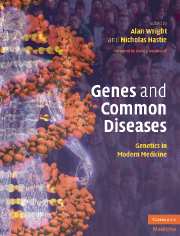Book contents
- Frontmatter
- Contents
- List of Contributors
- Foreword
- Section 1 Introductory Principles
- 1 Genes and their expression
- 2 Epigenetic modification of chromatin
- 3 Population genetics and disease
- 4 Mapping common disease genes
- 5 Population diversity, genomes and disease
- 6 Study design in mapping complex disease traits
- 7 Diseases of protein misfolding
- 8 Aging and disease
- 9 The MHC paradigm: genetic variation and complex disease
- 10 Lessons from single gene disorders
- 11 Environment and disease
- 12 Contemporary ethico-legal issues in genetics
- Section 2 Common Medical Disorders
- Index
- References
11 - Environment and disease
Published online by Cambridge University Press: 17 August 2009
- Frontmatter
- Contents
- List of Contributors
- Foreword
- Section 1 Introductory Principles
- 1 Genes and their expression
- 2 Epigenetic modification of chromatin
- 3 Population genetics and disease
- 4 Mapping common disease genes
- 5 Population diversity, genomes and disease
- 6 Study design in mapping complex disease traits
- 7 Diseases of protein misfolding
- 8 Aging and disease
- 9 The MHC paradigm: genetic variation and complex disease
- 10 Lessons from single gene disorders
- 11 Environment and disease
- 12 Contemporary ethico-legal issues in genetics
- Section 2 Common Medical Disorders
- Index
- References
Summary
Defining “environment”
The “environment”, considered in relation to health, typically refers to air pollutants, chemical residues in food, contaminated drinking water, radioactive wastes and so on. Conventionally, therefore, “environmental health” refers to research and policy in relation to the health risks posed by ambient environmental exposures. These exposures usually impinge on whole neighbourhoods, communities or populations and are therefore usually not under the control of individuals. This has important implications for prevention strategies.
Environmental risks to health from ambient physical, chemical and microbiological factors induce harm via direct physical, toxicological or microbial action. In addition to these various well-recognized human-made environmental exposures there are many important naturally occurring environmental health hazards. These include exposure to solar radiation, extreme weather conditions, and chemicals naturally present in drinking water (e.g. fluoride).
A more inclusive definition of “environment” includes the built environment and the social environment. Indeed, the influences of urban design, housing quality, material circumstances, social diets, socioeconomic conditions and social relations upon disease patterns have claimed increasing attention from researchers. Similarly, some commentators include variations in self-determined exposures (as through tobacco smoking, dietary choices and contraceptive hormone use) as part of the suite of environmental influences on health. This wider perspective becomes important, for example, in considering environmental influences on the rise of obesity in modern urban populations. This incoming tide of obesity is essentially an “environmental system” problem, reflecting fundamental, community-wide, changes in the ways of living of contemporary urban dwellers, resulting in disequilibrium between energy intake and energy output.
- Type
- Chapter
- Information
- Genes and Common DiseasesGenetics in Modern Medicine, pp. 164 - 175Publisher: Cambridge University PressPrint publication year: 2007



